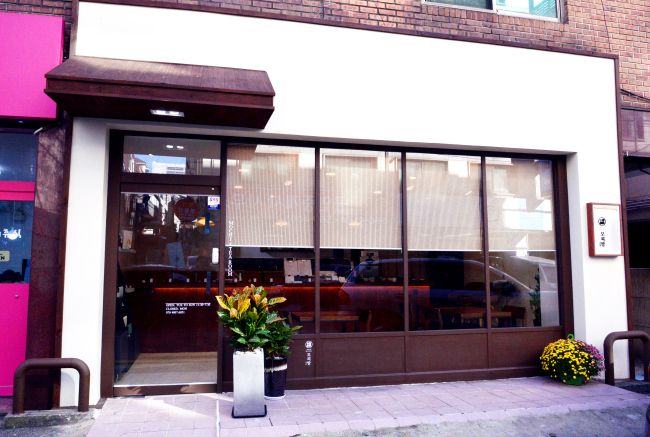At Mochibang -- a small, artisanal Japanese-style dessert shop -- one will find “ohagi.”
In fact, one will find several variations of the Japanese rice cake customarily served during the autumnal equinox.
 |
Mochibang specializes in wagashi, or Japanese sweets, with a focus on rice cakes like mochi and ohagi. (Photo credit: Park Hyun-koo/The Korea Herald) |
Owners Lee Bo-ra and Jeon Chan-hong fill their ohagi with everything from “marrons glaces” (candied chestnuts) to fragrant “yuja” (citron).
The marron glace makes its appearance in Mochibang’s toothsome chestnut ohagi.
Husband-and-wife team Jeon and Lee swaddle that candied chestnut with sticky rice and an outer layer of white bean paste that has been infused with marron glace syrup.
Rich bean paste, not quite smooth orbs of slightly salty glutinous rice and sweet, soft candied chestnut meld into a creamy, chewy and velvety mouthful.
Mochibang, which specializes in modern “wagashi” -- Japanese sweets -- officially opened this October in Seoul’s Daechi-dong.
“It took us a little over a year to plan it out,” said chef Lee, 29.
Lee and Jeon came up with the idea of specializing in Japanese sweets, namely rice cakes, while living in Australia where they drove a long distance to satisfy their cravings for rice cakes.
That initial idea has blossomed into a full-fledged dessert shop, with rice cakes taking center stage.
Since Lee and Jeon craft their rice cakes from scratch, careful attention is paid to the rice used and how it is prepared.
While a mixture of sticky and non-glutinous rice can be used to make ohagi, Lee says she and her husband use only glutinous rice for chewier ohagi.
While working with sticky rice to create their treats, Lee and Jeon felt the rice exhibited a certain bitter flavor.
“To get rid of that bitterness, we use water infused with yuja when soaking and cooking the glutinous rice,” said chef Jeon, 28.
For the ohagi, cooked sticky rice is mixed with a paddle until it is somewhat mashed up, so one can still feel the texture of the grains of rice.
For their “mochi,” which is served as “daifuku” (filled mochi) at Mochibang, pulverized glutinous rice is steamed with yuja-infused water and then pounded to that smooth texture characteristic of this rice cake.
In addition to mochi and ohagi, there is also Mochibang’s take on “ukishima” -- a steamed cake customarily made with bean paste, eggs and, depending on the recipe, flour. Mochibang‘s ukishima is made with bean paste, eggs and rice flour, said Jeon.
Tea, including matcha (pulverized green tea), and coffee are also on the menu, along with hojicha (roasted green tea) soft serve ice cream, which is served in a fragrant, creamy swirl and topped with hojicha powder.
Just over a month into business and Lee and Jeon are busy developing new treats for the winter, including an ohagi crafted with sweet potatoes and hojicha.
 |
Mochibang serves treats like chestnut ohagi (front, left), which features a marron glace coated in bean paste infused with marron glace syrup; creamy swirls of hojicha ice cream topped with powdered hojicha (back, right); and a steamed bean paste cake called ukishima (back, center). Treats can be paired with frothy bowls of matcha (front, right) or enjoyed with tidbits like candied nuts (back, left). (Photo credit: Park Hyun-koo/The Korea Herald) |
 |
Mochibang, a Japanese-style dessert shop, opened in Seoul’s Daechi-dong in October. (Photo credit: Park Hyun-koo/The Korea Herald) |
Mochibang
905-21 Daechi-dong, Gangnam-gu, Seoul
(070) 4007-6851
Open from 11:30 a.m. to 7:30 p.m. daily, closed Mondays
Ohagi costs 2,800 won to 3,500 won, mochi costs 2,500 won to 3,200 won, ukishima costs 2,000 won, tea, coffee and lattes cost 4, 500 to 6,800 won, ice cream costs 4,800 won
By Jean Oh (
oh_jean@heraldcorp.com)










